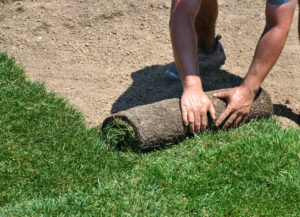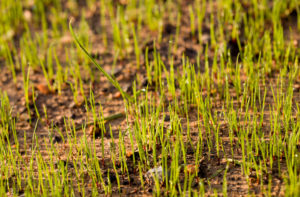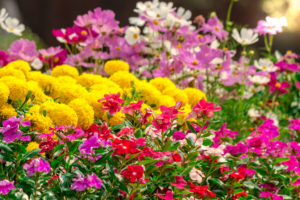First 2 Weeks
The key to establishing new sod is to keep it properly watered for the first month. Immediately after installing sod, water thoroughly making it spongy to the step. The new sod should be kept thoroughly wet to a depth of 4″ to 6″ and watered 2 to 3 times a day during the first 7 to 14 days depending on the season. Lift a corner of the sod to determine the depth of moisture. In the first week, it is very important to keep the new sod damp. During this time stay off the sod so it can take root and you do not sink in and leave depressions from your foot steps. During hot weather, sprinklers should run several times a day so the new sod never dries out. If allowed to dry out, the sod will shrink, brown, and can die. The roots of your new sod will penetrate the soil faster and root down sooner if properly watered. At the end of week 2, dry up the yard enough so you can mow.
 Weeks 3 & 4
Weeks 3 & 4
The following 2 weeks are used to transition from frequent daily watering to fewer cycles per day and increase the number of days between waterings. During week 3, reduce waterings to 1 time per day and skip a day between watering if the new sod is not drying out. By week 4, water 1 to 2 times every other day. After week 4, your new yard should be ready to go 2 to 3 days between watering. Water your lawn in the evening or early morning when less evaporation occurs. To reduce run-off on hills and promote deep root growth, reduce watering times in half. One hour later, run the irrigation cycle again and apply the rest of the water. This allows the water to soak into heavy soils.
Rest of the Season
Your new lawn will need more water the first growing season and especially the first 6 months. As it roots deeper over the course of a year, it will need less water. If your lawn looks dry, it probably needs watering. The key to new sod care during this time is deep watering less frequently. This will help the roots grow down and develop a deep root system that uses less water. It is OK after the first two months to stress your lawn a little. This means let your yard dry out a bit and when you see signs of stress starting to appear, make sure to water. This will also allow you to fine tune the sprinkler system and adjust heads for proper coverage and change nozzles for more or less water in certain spots.
Mow if Grass exceeds 3.5″
Your new lawn should be mowed at the end of week 2 or if you lawn exceeds 3 1/2″ tall. Back off on the watering so the turf is dry to the touch and firm enough to walk on without sinking in. If your new lawn reaches over 3 1/2″, mow off a third of the length even if it has not been two weeks. Do not cut shorter than 2″ for the first few times you mow. Exercise caution the first time you mow so you do not damage or pull up the sod. If some of the sod does move around, don’t worry. Just put it back in place and it will grow in.

 As your new lawn becomes established, you can start easing up on the water, depending on the weather. If you continue your everyday watering routine, you’re likely to overdo it and rot the young seedlings. Also, if the ground is too wet, you can inhibit root growth.
As your new lawn becomes established, you can start easing up on the water, depending on the weather. If you continue your everyday watering routine, you’re likely to overdo it and rot the young seedlings. Also, if the ground is too wet, you can inhibit root growth.
 We observe our surroundings with multi-faceted senses. We don’t just notice a home’s color, but its noises, textures, and even smells. With a yard, you observe not just the plants and the lawn, but the environment’s creative arrangement. Are the flowers’ blooming seasons thoughtfully timed? Are there chairs in areas you’d like to sit? Are the yard accessories like fences, gates, and children’s play sets arranged functionally?
We observe our surroundings with multi-faceted senses. We don’t just notice a home’s color, but its noises, textures, and even smells. With a yard, you observe not just the plants and the lawn, but the environment’s creative arrangement. Are the flowers’ blooming seasons thoughtfully timed? Are there chairs in areas you’d like to sit? Are the yard accessories like fences, gates, and children’s play sets arranged functionally?